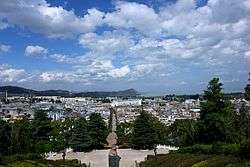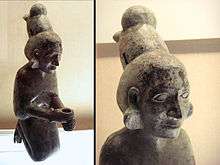Jinning District
Jinning District (simplified Chinese: 晋宁区; traditional Chinese: 晉寧區; pinyin: Jìnníng Qū) is one of seven districts of the prefecture-level city of Kunming, the capital of Yunnan Province, Southwest China. The district was approved to build from the dissolution of the former Jinning County (晋宁县) by the State Council on November 24, 2016.[1] It is located at the southern tip of Dian Lake and is well known within China as the birthplace of Zheng He.
Jinning 晋宁区 | |
|---|---|
District | |
 Kunyang Town in Jinning | |
.png) Location of Jinning (pink) and Kunming City (yellow) in Yunnan province | |
| Country | People's Republic of China |
| Province | Yunnan |
| Prefecture | Kunming Prefecture |
| Established | 1956 |
| Area | |
| • Total | 1,230.86 km2 (475.24 sq mi) |
| Population (2003) | |
| • Total | 270,000 |
| • Density | 220/km2 (570/sq mi) |
| Time zone | UTC+8 (CST) |
| Postal code | 650600 |
| Area code(s) | 0871 |
| Website | http://www.jinning.gov.cn/ |
Nature
The southwestern "panhandle" of Jinning District (Xiyang Township 夕阳乡) contains two caves (Yanzi and Shitou) known for their bat population. Starting from the early 2010s, researchers from the Wuhan Institute of Virology and EcoHealth Alliance carried out studies of viruses carried by those bats, discovering some that were fairly close to the Severe acute respiratory syndrome coronavirus. A 2018 study found antibodies to some of these bat viruses in the blood of a few villagers residing near the bat caves as well, indicating that some of them may have been exposed to bat coronaviruses.[2] [3]
History
In 303 CE, during the Jin dynasty, Li Xiu became commander of the area after the abrupt death of her father, defeating a local rebellion after lasting a seven-year siege.[4]
Administrative divisions
Kunyang Town, Jincheng Town and Baofeng Town, Erjie Village, Shuanghe Yi Nationality Village, Xiyang Yi Nationality Village, Shangsuan Village, Xinjie Village and Lujie Village
Ethnic groups
According to the Kunming City Almanac (1997:476), ethnic Hani are found in Gaoliangdi (高粱地)[5] and Xiyang (夕阳)[6] of Xiyang Township (夕阳乡), Jinning County.
Transport
Social issues
In October 2014 Fuyou village (Chinese: 富有村) in Jinning was the scene for a violent clash between construction workers and villagers, leading to death of eight people. The residents had been unhappy about a land deal related to building of a trade and logistics centre.[7][8]
Monuments

The Shizhaishan Tombs (Shizhaishan gumuqun 石寨山古墓群), and the grave of Ma station Hazhi (Ma Hazhi mubei 马哈只墓碑) in the greater community Kunyang, the father of Zheng He, are since 2001 and 2006 respectively on the list the monuments of the People's Republic of China.
References
- 晋宁区历史沿革 (in Chinese). xzqh.org. 2016-12-02. Retrieved 2019-07-19.
- Wang N, Li SY, Yang XL, et al. Serological Evidence of Bat SARS-Related Coronavirus Infection in Humans, China. Virol Sin. 2018;33(1):104‐107. doi:10.1007/s12250-018-0012-7
- Ge, Xing-Yi et al. “Isolation and characterization of a bat SARS-like coronavirus that uses the ACE2 receptor.” Nature vol. 503,7477 (2013): 535-8. doi:10.1038/nature12711 (This paper does not specifically indicate the location of the caves, but the 2018 paper clearly indicates that the 2013 paper deals with bats from the same two caves).
- "Li Xiu - defender of Ningzhou - ColorQ Articles Etc". www.colorq.org. Retrieved 2019-06-06.
- http://www.ynszxc.gov.cn/villagePage/vIndex.aspx?departmentid=104450
- http://www.ynszxc.gov.cn/villagePage/vIndex.aspx?departmentid=104441
- "China building site clash leaves eight dead". BBC News. 15 October 2014. Retrieved 24 October 2014.
- "China 'punishes 17 officials' after deadly village clash". BBC News. 24 October 2014. Retrieved 24 October 2014.